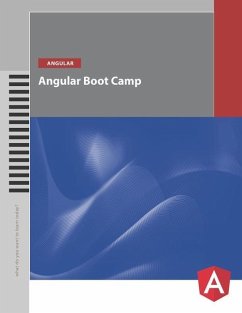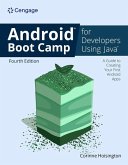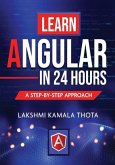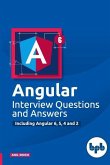Student and instructor-led training manual for building web applications with the Angular framework. 1. Relevant, timely and up-to-date resources for each chapter 2. Over 450 pages of content, including: 3. Lectures 4. 40+ Guided Exercises (to be done with the instructor) 5. 8+ Practice Exercises (to be done with or without instructor guidance) 6. 10+ Challenge Exercises (to be completed by the student) 7. Numerous Homework Exercises (to be done after class, or in-class for advanced students) 8. Quizzes 9. Games 10. Links to micro-learning content such as: * Posters/Infographics * Interactive webpages for review of material * Simple quizzes for spaced learning * Demo files demonstrating previously encountered subject matter This course provides the necessary information for building websites and web applications using the Angular framework. Throughout of the course, attendees will build a simple web application while covering the required fundamental topics. By the end of the course, the learner will be able to: * know where to find help while building Angular applications * install browser extensions that will help debug Angular applications * install all of the software and tooling required to build Angular applications * use nodejs and npm or yarn to install code into projects * run a command line interface * fetch code from a public code repository * test the installation of the software and tools required to build an Angular application * build the first phase of any Angular application * clone an Angular application from a code repository * properly scaffold an Angular application * create the HTML content seen by the user in a web browser * use modern TypeScript techniques that simply the creation of web applications * use Google's Angular Command Line Interface tool to make code modules that make up an Angular web application * add features to an application using reusable components * customize the look and feel of their Angular applications without using redundant code * use 3rd party style libraries to quickly style Angular applications * reuse application components by substituting different content for each use case * control the applications component data quickly and efficiently * add dynamic content in the user interface that changes depending on user activity * add features and business logic to their application * easily add predefined functionality to an application's components using dependency injection * share data between components using a simple method * share application functionality in multiple applications * change the user interface of the application through DOM manipulation by hiding and showing features programmatically * allow the user to move from screen to screen while interacting with the application * collect data from the user by adding forms to the user interface * send data to any part of the application that needs it using RXJS observables * retrieve data from a server, process and display the data in the user interface of the application * format data displayed in the user interface as numbers, currency, and the like including custom formats * prohibit users from accessing parts of the application * prevent users from leaving a screen such as an incomplete form without first receiving a warning * allow users to read create, read update and delete data on the server * use the two testing frameworks that come with the Angular framework * write tests that confirm that their code functions as expected * describe how an Angular application bootstraps * use semantic versioning to version their web applications * understand the basics of web app development
Hinweis: Dieser Artikel kann nur an eine deutsche Lieferadresse ausgeliefert werden.
Hinweis: Dieser Artikel kann nur an eine deutsche Lieferadresse ausgeliefert werden.








